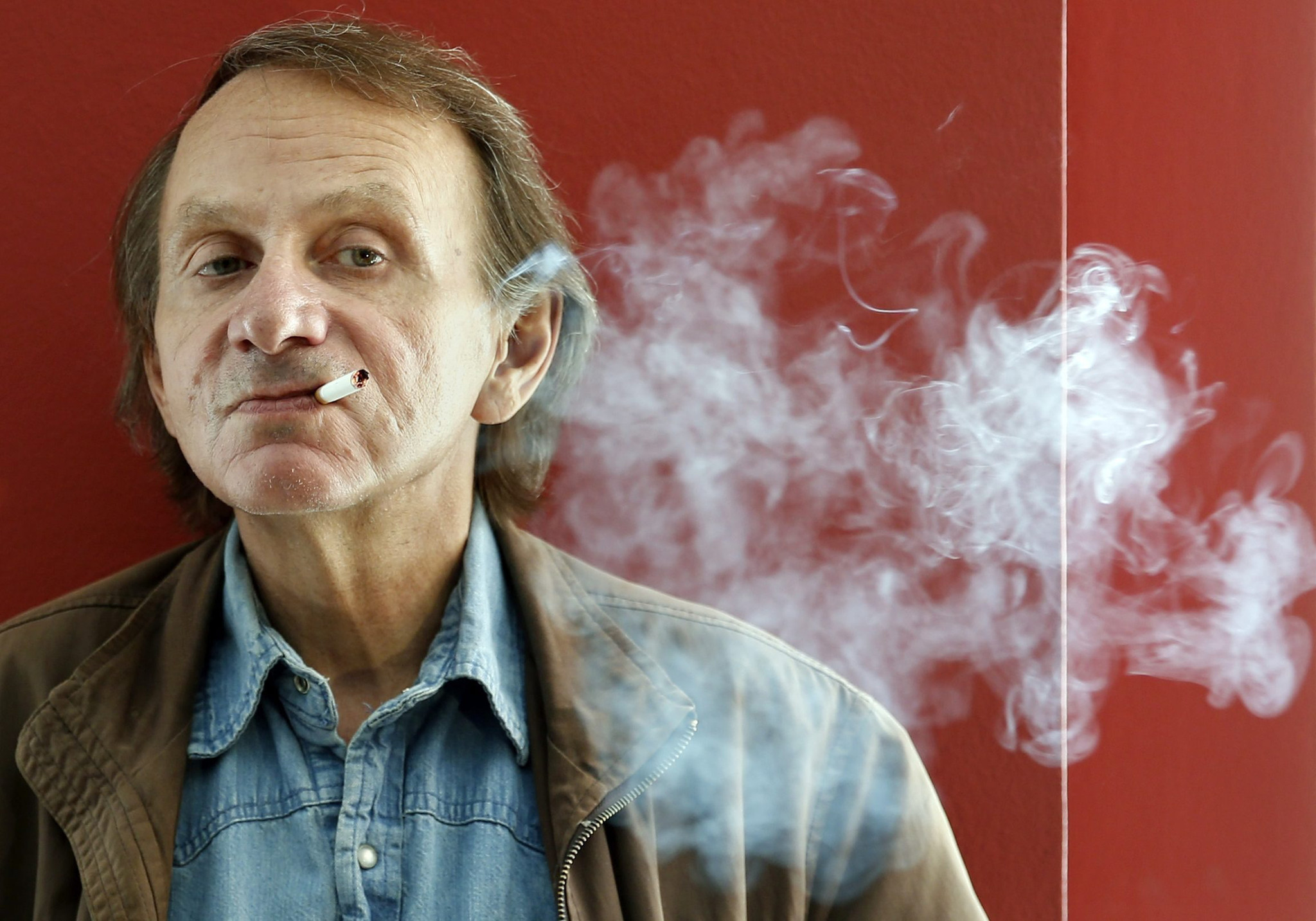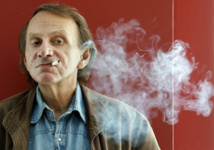There is even a bar reminscient of the wife swapping clubs of his novel "Atomised" where visitors can pause for a smoke and a beer -- two of the writer's favourite vices -- to contemplate the full glorious emptiness of modern existence.
"I had not, more than most people, a real reason to kill myself," he declares in the opening rooms next to his shots of the drab "Suburban Avalon" in which he grew up on the edge of Paris.
The show spread over 18 rooms of the Palais de Tokyo gallery reveals not just Houellebecq the accomplished photographer-poet and cynical social commentator, but Houellebecq the dog lover, maker of lesbian soft porn films and disappointed romantic in love with the landscapes of rural France.
"My loyal readers will I hope rediscover my principal idiosyncracies," he said in the catalogue. "A clear taste for megalomaniac nonsense and the impression that I put everything in."
His photographs range from a discount supermarket contrasted with a chateau built into a cliff-face along France's Dordogne river to a young woman who Houellebecq said was "a distant inspiration" for the character Esther in "The Possibility of an Island" shot in S&M gear.
"Esther really liked that kind of clothing... I too like this kind of clothing. I have my little, really little vices," he added.
- Erotic photos -
"These photos of Esther are moments from life, I didn't stage them at all... All men take erotic photos of their girlfriends, and they mostly like that."
Houellebecq said there were also photos of "Marie-Pierre, my ex-wife. When men are in love they look at women. They look at them a lot. Whenever I'm in love with a woman, I photograph her."
The show, called "To Stay Alive", also features watercolours by Marie-Pierre Gauthier of their dog, Clement, who the punk star Iggy Pop immortalised in his song "A Machine for Loving" inspired by Houellebecq's eulogy for his dead Corgi.
Curator Jean de Loisy said for Houellebecq Clement symbolised "unconditional love", and said that when he and Gauthier split -- "although they are still good friends" -- they divided Clement's toys equally.
He said Houellebecq was a true artist who had "multiple aspects to his work. He personally laid out and created the show as a vast installation which examines aspects of his life and work."
The show even includes a half-built red-brick reliquary for the writer's bones.
"It is an extremely rich and strong show," de Loisy added, with the visitor plunged into a total Houellebecqian world, bolstered by works by the French artists Renaud Marchand and Robert Combas inspired by the author.
Houellebecq said he organised the show as if he was putting together a poetry collection. "I think of myself as a producer of images rather than a photographer. I've organised the rooms so that they follow one another like in a book-length collection in which the poems produce a narrative."
Houellebecq's gift is to "shock, amaze and disconcert" in equal measure, literature professor Bruno Viard, who has written two books on the author, told AFP.
"He is not ashamed of his shame. His authenticity comes from his awkwardness, and he plays on his existential failures."
"He is really the hero of his books," acclaimed French writer Pierre Assouline added.
-------------------------------------------------------------------------------------------------
"I had not, more than most people, a real reason to kill myself," he declares in the opening rooms next to his shots of the drab "Suburban Avalon" in which he grew up on the edge of Paris.
The show spread over 18 rooms of the Palais de Tokyo gallery reveals not just Houellebecq the accomplished photographer-poet and cynical social commentator, but Houellebecq the dog lover, maker of lesbian soft porn films and disappointed romantic in love with the landscapes of rural France.
"My loyal readers will I hope rediscover my principal idiosyncracies," he said in the catalogue. "A clear taste for megalomaniac nonsense and the impression that I put everything in."
His photographs range from a discount supermarket contrasted with a chateau built into a cliff-face along France's Dordogne river to a young woman who Houellebecq said was "a distant inspiration" for the character Esther in "The Possibility of an Island" shot in S&M gear.
"Esther really liked that kind of clothing... I too like this kind of clothing. I have my little, really little vices," he added.
- Erotic photos -
"These photos of Esther are moments from life, I didn't stage them at all... All men take erotic photos of their girlfriends, and they mostly like that."
Houellebecq said there were also photos of "Marie-Pierre, my ex-wife. When men are in love they look at women. They look at them a lot. Whenever I'm in love with a woman, I photograph her."
The show, called "To Stay Alive", also features watercolours by Marie-Pierre Gauthier of their dog, Clement, who the punk star Iggy Pop immortalised in his song "A Machine for Loving" inspired by Houellebecq's eulogy for his dead Corgi.
Curator Jean de Loisy said for Houellebecq Clement symbolised "unconditional love", and said that when he and Gauthier split -- "although they are still good friends" -- they divided Clement's toys equally.
He said Houellebecq was a true artist who had "multiple aspects to his work. He personally laid out and created the show as a vast installation which examines aspects of his life and work."
The show even includes a half-built red-brick reliquary for the writer's bones.
"It is an extremely rich and strong show," de Loisy added, with the visitor plunged into a total Houellebecqian world, bolstered by works by the French artists Renaud Marchand and Robert Combas inspired by the author.
Houellebecq said he organised the show as if he was putting together a poetry collection. "I think of myself as a producer of images rather than a photographer. I've organised the rooms so that they follow one another like in a book-length collection in which the poems produce a narrative."
Houellebecq's gift is to "shock, amaze and disconcert" in equal measure, literature professor Bruno Viard, who has written two books on the author, told AFP.
"He is not ashamed of his shame. His authenticity comes from his awkwardness, and he plays on his existential failures."
"He is really the hero of his books," acclaimed French writer Pierre Assouline added.
-------------------------------------------------------------------------------------------------









 Home
Home Politics
Politics











